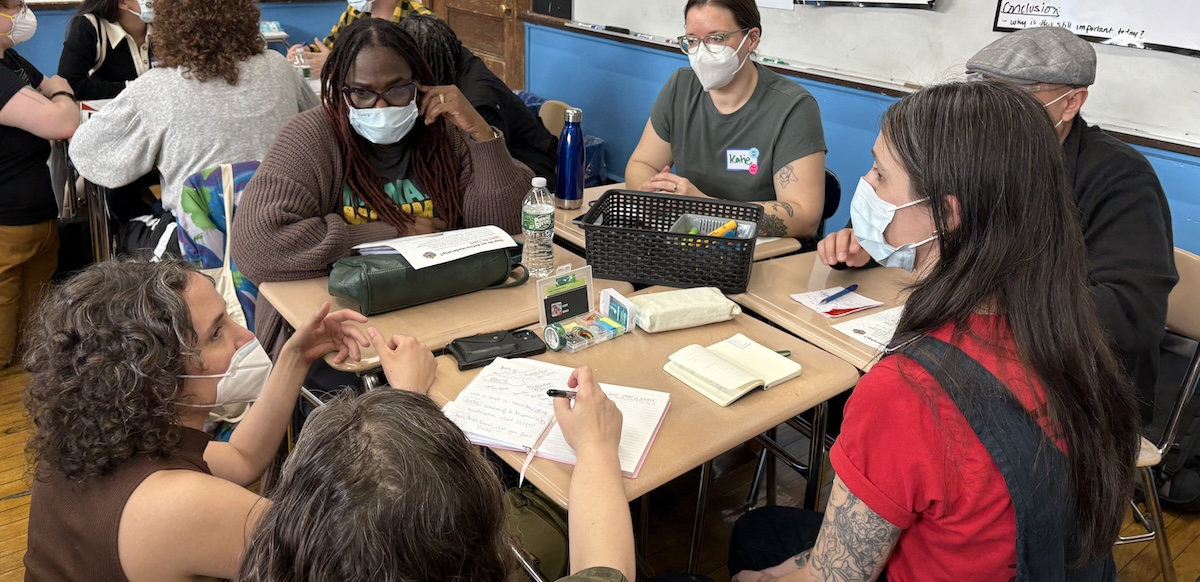Steward’s Corner: Engaging Critics Can Create a Stronger Local

Not paying dues is often a way someone chooses to be an activist. They have something to say, and without an outlet, they shut down. Photo: Jenny Brown
Factions often emerge in local unions—and they aren’t necessarily a bad thing. But a local union’s “divided government” can be problematic, especially when a contract campaign is on the horizon.
Often “factions” happen when certain members frequently criticize the local leadership, and leaders push back. The division may appear to be hostile, but often the underlying tension comes from frustration and lack of communication on both sides.
For union leaders, pushing back against critics is often the natural human reaction. But as the leader of a teachers’ union local, I have found that it’s usually better to be inclusive. When I encounter members who are upset with the direction of the union, my practice is to view it as an opportunity.
In my previous job, I pushed for a strong member program, and often it included people who were highly critical of leadership. I would sit with people who did not pay their dues and ask them what they thought should be going on in the school district.
Hearing their views often strengthened my thinking. A good number of dues-paying members felt the same way as the non-dues-payers who complained to me. Not paying dues is often a way someone chooses to be an activist. They have something to say, and without an outlet, they shut down.
I’ve used something called a Rogerian process in talking with critics. This process, first developed by psychotherapist Carl Rogers, is aimed at increasing understanding among people on both sides of an argument, sometimes enabling them to come up with mutually beneficial solutions. Steps for each side include:
- Introduce the topic and the problem to be solved
- Outline the opposing position to your own (showing that you understand your opposition’s views and goals)
- Provide the context for that opposing position
- Outline your own position and the context for your position
- Discuss how people with the opposing position would benefit by adopting elements of yours
Using this process doesn’t mean that the leader gives up control or must arrive at a dead-middle compromise. But it does increase the leader’s perspective, giving them greater authority.
INVOLVE CRITICAL MEMBERS
I also look for ways to involve critical members’ energy. This has helped me gain perspective and given me some good ideas. In the process, it gives the critics an empowering outlet. When a person feels that they can help enact change, they will continue to be a change agent in a positive way.
Let’s say the union is negotiating over health care. It’s tense, because the issue affects everyone. Members are passionate about keeping costs down and coverage up because they care about their kids and spouses. Union leaders are in the same boat, and often feel burdened when members get critical, because they’re doing the best they can. And usually what they negotiate is the best they think the union can get. The situation creates a lot of upset.
The people who are the most critical are often told that they are just wrong or that they don’t understand. But these folks can be a benefit, not a burden. Often the member creating all the angst is right about many things, though their proposed solutions may not be practical.
CALL FOR RESEARCH
I try to engage them by calling for research. I ask them to find me ideas, plans, and articles that point to solutions. I make sure not to insult them. And I practice the Rogerian argument, which honors their views, while also providing greater clarity about a complex issue. The exchange often shows members how difficult a union leader’s job really is.
I have known unions where different groups (or factions) were at each other’s throats. Members were upset. They felt excluded and not welcomed. My suggestion was to involve them. Encourage them to run for office or head committees. And then listen to them, knowing that they have something to contribute. After some time, the negativity stops and more gets done. No matter how much they anger you, members are not the problem.

SUPPORT LABOR NOTES
BECOME A MONTHLY DONOR
Give $10 a month or more and get our "Fight the Boss, Build the Union" T-shirt.
What does all this change in the longer term?
I saw a steady increase in participation at building meetings and general membership meetings. I saw a problem-solving mindset take over. And I was able to convert non-members who were working against union activity into dues-payers, even when people told me it wasn’t possible.
This approach creates transparency. It fosters trust. It increases engagement so that leaders don’t have to find all the solutions. It takes the union from an “I have to do it” mindset to a “we can do it” mindset. It turns the “I” into “we.”
Paul Ruth is currently a building rep with AFT-Michigan Local 681 in Dearborn.



